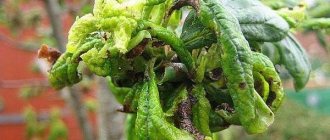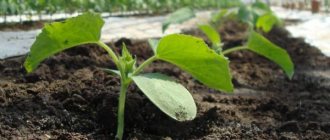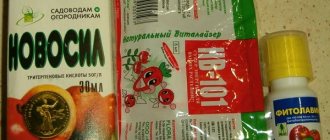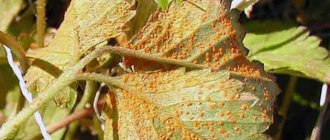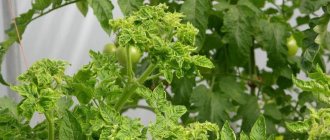When planting young pear trees on their plot, many gardeners do not even suspect that they may encounter such a nuisance when the pear leaves suddenly turn black. In the meantime, this problem appears quite often, especially if the owner of the personal plot did not initially study the basic rules for caring for a young plant. Therefore, before planting, you should definitely take into account all the features of the fruit crop and carefully care for the pear in order to get a harvest of tasty and juicy fruits.
Main causes of blackening
Spots on pear leaves
If the leaves on a pear turn black and curl, this indicates that the plant is not receiving enough care or is sick. There can be quite a few reasons for this event, and it is very important to determine the correct one in order to take measures to eliminate it.
The most common reasons are:
- various diseases;
- pathogens and pests;
- care inappropriate for wood.
Before growing a tree on your own plot, you need to consider all possible negative aspects. If the gardener is armed with special knowledge about diseases and pests that often affect the plant, and also learns how to properly care for the pear, problems should not arise.
Pear diseases
Bacterial damage is one of the main reasons why pear leaves turn black and sometimes even curl. Such signs indicate a fairly serious attack by pathogenic microflora, which must be dealt with immediately.
Common pear diseases are:
- bacterial burn;
- scab;
- fruit rot;
- sooty fungus;
- black pear cancer.
Bacterial burn
Pear affected by fire blight
Bacterial burn is the name of the disease that causes blackening and curling of pear leaves. It is especially often activated during periods of heat and high humidity, when the weather is rainy.
In this case, the young ovaries and peduncles begin to turn black first. To defeat the disease, you can try to treat the shoots with special means, for example, Fitolavin or Gamair. At the end of June - July, when fire blight activity is highest, the condition of the fruit tree should be checked regularly.
The next to be affected are young shoots and leaves, which become covered with brown stains and dark spots. At high speed, the spots spread throughout the entire crown, and the leaves begin to curl. This happens in a short time and if the damage is severe, the tree looks like it has been burnt. That is why the disease is called a burn, due to the external similarity of the signs of the lesion.
Young pears under 10 years of age are considered most susceptible to fire blight. According to some data, this occurs as a result of underdeveloped immunity in young plants, as well as the occurrence of certain physiological processes that slow down in adulthood.
Pears growing in the southern regions of our country suffer from frequent fire blight. This depends on the hot climate, in which the disease can spread very quickly, as well as the least resistance of southern plants and their reduced immunity.
Bacteria are easily carried by the wind, as well as on the paws of animals and birds; infection through insects is possible.
Often, the gardener himself becomes the culprit for infecting the pear, as he uses an unsterile tool for pruning the pear.
Parzha
Parza on a pear
Scab can also affect pear and apple trees. In hot and humid summer conditions, the disease develops very quickly and can affect all fruit plants on the site. If a diseased plant is not treated promptly, over time the disease will affect all the trees in the garden.
The fungal disease actively develops immediately after the first leaves bloom. First, small brown-yellow spots appear on them, which turn black over time, covering almost the entire surface of the leaf. The spores usually “overwinter” in fallen leaves and, when warmer weather sets in, they quickly begin to cover the entire crown of the pear tree.
Pear fruits that have managed to develop on a diseased plant are distinguished by a not very pleasant taste, hard cork-like pulp and a huge number of dark spots on the peel. There are several varieties of pears that are relatively resistant to fungal attack.
These varieties include:
- Strawberry;
- Dessert and others.
But there are varieties that, on the contrary, are more susceptible to this fungal infection. This point should be taken into account when choosing seedlings for your orchard.
Moniliosis
Moniliosis or fruit rot is another reason that can cause pear leaves to curl and become covered with black spots. This disease is also caused by fungi. The fruits of the plant are the first to suffer. The first signs will be noticeable at the very beginning of the pears; they are covered with small black spots, and then this rot spreads over the entire surface of the fruit.
Over time, the pear becomes loose and tasteless. Such fruits are not suitable for food. With the rapid and active development of the disease, if it is not treated in time, branches and leaves will be affected after the fruit. When covered with spots, the pear leaves turn black gradually, but very quickly. The end result of the disease is completely dried out branches of the plant.
Other diseases
Sooty fungus on pear fruits
Sooty fungus affects plants during flowering or the appearance of the first ovaries. The spread of the disease is usually associated with one of the following factors:
- insufficient light reaching the tree;
- the crown is too thick, into which fresh air and light do not pass well;
- the place where the tree grows is located in a lowland and there is stagnation of water during rainy weather or watering;
- impact of insect pests on the tree.
As a result of the tree being damaged by a fungal disease, the leaves of the pear turn black and become covered with a dense dark coating. At the same time, it can be easily removed from the affected leaf; this is how the disease in a fruit plant is determined.
Sooty fungus infestations most often occur during periods when insects are active. Pests secrete a special sugary liquid, which, in turn, turns into an excellent environment for the development of a fungal infection.
Black cancer on a pear
Cytosporosis or black fruit tree canker is also a common disease in fruit trees. The bark and branches of the pear, especially young shoots, are affected first. If the disease develops severely, if it is not treated in time with special means, the leaves and fruits of the tree will suffer.
The first sign of the disease is the appearance of small black spots on the pear bark that ooze gum. Experienced agronomists and gardeners believe that the disease cannot be completely cured, but with the use of various remedies and folk recipes it is possible to slow down the pathological process or even stop it.
Gall mite
Small pests are practically indistinguishable. Up to one and a half thousand individuals can overwinter in one bud. Each female lays up to six viable eggs. The larvae grow quickly, develop, and cause irreparable harm to the pear. The following drugs are used for control:
- Neoron;
- Apollo;
- Nissan;
- Akarin;
- Flumite;
- Omite.
Pests are located on the outer part of the leaves, depriving the plant of nutrients. If the leaf turns black and withers, this may be a symptom. Shoots and leaves deprived of substances wither, the growth of new shoots stops. The kidneys also dry out. An affected plant can leave the owner without a harvest. In case of severe damage, you can use chemicals. After harvesting, Kemifom, Carbofox, Fufanon are used. It is not recommended to use them during fruit ripening.
Dangerous pests
Aphids on a pear
Many pests can spoil a fruit-bearing tree. Some are quite easy to get rid of, while others bring a lot of trouble. The most common pests that can cause blackening of pear leaves are:
• aphids; • slowpoke; • leaf roller.
Aphids and leaf rollers are dangerous insects for the health of a pear tree. They actively reproduce and infect almost all leaves on the tree. First, the tips of the pear leaves turn black, and then the entire crown becomes covered with a black coating, gradually drying out.
The copperhead is a small insect with transparent wings. The pest can jump or fly short distances from tree to tree. They suck out the nutritious juice from the shoots on the young pear and leaves, as a result of which the ovaries that appear fall off, and the leaves stop actively growing, become small and inconspicuous.
During the life of the winged pest, a sweetish coating forms on the crown of the tree. It is an ideal environment for the proliferation of fungal infections, in particular sooty rot.
Aphid
One of the common causes of blackening of leaves. The leaves darken and curl. They turn black and fall off. Over time, the damage increases, young shoots dry out. Aphids are easily destroyed by chemicals and folk remedies.
Expert opinion
Stanislav Pavlovich
Gardener with 17 years of experience and our expert
Ask a Question
Important! If the leaf has dried out due to a pest attack, then insects can be found on the bottom of the leaf.
There are green aphids and leaf rollers. Small insects suck nutrients from leaves and young shoots. If the leaves are covered with small pests, then Aktelik, Iskra, Kemifos will help. Preventative treatment in early spring is important to prevent the appearance of aphids on the site.
Pear care
Watering pears
Insufficiently careful care or improper measures to maintain the normal health of the tree can also cause pear leaves to curl and become covered with a black coating. The lack of necessary micro- and macroelements in the soil can manifest itself in this way.
A lack of calcium, if the tree grows in acidic soil, is characterized by the appearance of dark yellow spots on the leaves . They then begin to darken and dry out, subsequently leading to complete drying of the branches and leaves.
Boron deficiency can also manifest itself in the form of blackening of fruits and leaves, but the leaves also curl into a tube. If you do not start treating the tree in time, the tips of the young shoots will begin to dry out and this will lead to the death of the fruit-bearing tree.
Insufficient environmental humidity and high dust content in the atmosphere also lead to such unpleasant manifestations as blackening of leaves. The pear tree needs to be watered thoroughly if the weather is dry and sunny outside.
How to treat
To get rid of blackening of the pear, you need to know exactly the cause of the disease. How to treat blackening leaves on a pear depends on the etiology of the lesion. If the cause of the damage is improper care, then you need to improve your agrotechnological skills and monitor the condition of the pear. If there is an imbalance of minerals and vitamins in the soil, additional fertilizing is applied or the acid-base balance of the soil is normalized.
Bacterial infections are treated with phyto-antibiotics. Such medications are produced in the form of a powder, which must be diluted with water and sprayed on the tree. Phytoncidal antibiotics are also available in the form of cream and ointment. This form of medicine is good for small lesions. The effectiveness of ointments, creams and liniments is higher than that of a liquid solution of antibiotics.
If pear leaves turn black due to a fungal disease, then antifungal drugs are involved in the treatment. Antifungal solutions are most often produced in the form of sprays in high concentrations. Using a spray bottle, not only the leaves of the pear are sprayed, but also its branches and trunk. If mycotoxicosis begins to develop from below, then the pear is watered at the root with an antimycotic diluted liniment. Watering with regular tap water should be avoided. On average, 1 adult pear requires up to 30 liters of antimicrobial solution. After watering, the root circle is covered with film so that rain does not accidentally seep into the root of the tree.
Fighting leaf blackening
Pear processing
Many gardeners who have not yet gained experience often ask the question of how to treat if the leaves on a pear turn black and curl. The fact is that treatment should be started only after the cause of such an unpleasant phenomenon has been determined.
The gardener must note all the pathological signs and determine for himself whether the blackening is a consequence of pest activity or pathological processes, or whether the tree simply lacks nutritional components important for its development.
The easiest way to solve the problem is with mineral and organic supplements. If, for example, a tree lacks calcium, it will be enough to simply apply calcium nitrate under the tree in accordance with the instructions. The microelement deficiency will be replenished and the tree will begin to actively grow and develop again.
If the tree lacks moisture, it is enough to simply treat it with ordinary water, regularly spraying the crown and watering the plant. Over time the problem will be solved.
It will be more difficult to defeat infectious and pathological processes, especially bacterial burns. In official sources for the fight against plant diseases there is no substance that will help effectively cope with the disease. But with the help of conventional medications and antibiotics, gardeners often stop the development of the disease, allowing the tree to overcome the disease.
Agrotechnical measures
Feeding pears
Often it is enough just to carry out certain agrotechnical procedures for the plant to restore its health and produce a rich harvest of tasty fruits. They need to be carried out according to a certain scheme within a specific time frame.
This care includes:
- cleaning the tree trunk circle from plant debris;
- digging up the soil around the trunk while simultaneously applying organic and mineral fertilizers;
- treating the tree with hot water until the buds open;
- during the period when the first buds appear, it is recommended to treat with a fungicide, for example, “Agate”;
- after flowering, the plant requires phosphorus and potassium, they are added to the soil;
- after 20 days, repeat treatment with fungicides;
- in mid-July the last, third fertilizing with organic fertilizers is carried out; wood ash and humus are used here;
- in the fall, you need to prepare the tree for wintering; for this purpose, sanitary pruning of branches is carried out and all plant debris is burned to avoid plant diseases;
- the kidneys also need to be treated with a 5% urea solution;
- if it is necessary to disinfect the soil in the tree trunk circle, use the same urea solution, but with a concentration of 7%;
- The trunk and large branches of the tree must be treated with lime mortar with the addition of copper sulfate.
Timely treatment will avoid blackening of the tips of pear leaves and further development of the disease. The main thing is to carry out sanitary procedures on time, before pests or diseases affect the fruit tree.
Biologically active agents
In modern production, a number of safe biological products have appeared that can cope with diseases manifested by blackening of leaves. They are safe for plants and humans and can stop the pathological process of even bacterial burns. The whole secret is in the beneficial bacteria contained in these products. They actively act on the plant, helping to recover and relieve symptoms of the disease.
A substance such as Fitolavin is effective against bacterial burn. This product has a really strong effect. In the fight against sooty rot, the drugs Siyanie and Baikal showed good results. A solution is made from them in accordance with the instructions and the pear tree is processed.
Chemicals
Fitosporin
Fungal infections, which appear as blackening on the leaves and branches of pears, are treated with radical methods using chemicals. Immediately after detecting the first signs, you need to treat the plant with copper-containing substances. You can prepare them yourself or buy a ready-made solution, which will subsequently be used to treat the pear plantings on the site.
Spring and autumn treatments with these products perform well. If the buds have already blossomed, you will have to use fungicides, for example, Fitosporin or Topsin. For pest damage, insecticides such as Biotlin or Alatar are suitable.
Folk recipes
Spraying pears in spring
The simplest, but more labor-intensive treatment option is spraying with plain water, or water with the addition of 70% medical alcohol. The procedure should be carried out regularly for a couple of weeks. The water pressure effectively removes insect pests from the surface of the foliage.
Various herbal infusions have also worked well. For example, garlic, tansy or yarrow. They need to be filled with water and left for several days. Then add wood ash, increase the volume to 10 liters and spray the plant. This needs to be done regularly. It should also be noted that traditional control methods are effective only in the early stages of pear disease.
Treatment of infections
If a bacterial burn, scab or cytosporosis is detected, measures should be taken immediately. If signs of bogging appear against the background of black spots or leaf curling, it is necessary to treat with chemicals:
The first treatment is carried out at the moment the buds swell and the juices awaken. When characteristic spots appear, gardeners collect and dispose of fallen leaves. Scab-affected shoots are cut off and the sections are treated with varnish to protect against infection. The soil around the pear is dug up with the addition of a 1% Nitrafen solution. Additional spraying is carried out after leafing out, flowering and harvesting.
In case of bacterial burn, it is better to completely remove the affected branches. When “symptoms” appear, the pear is sprayed with fungicides Energy, Previkur, Skor. They can be mixed with antibiotics Streptomycin, Ofloxacin, Tetracycline. Treating the trunk and crown with 1% Bordeaux mixture before wintering helps combat dryness.
Prevention methods
Pear pruning
Timely care and implementation of basic agrotechnical measures will already provide excellent prevention of fungal infections and the development of various diseases. Experienced gardeners always carry out preventive treatment of garden trees in order to have high-quality plantings and get a good harvest. Preventive procedures include:
- regular pruning of branches (be sure to sterilize instruments before and after the procedure);
- ensure sufficient and timely watering, it is better to study this issue in advance, before planting a pear tree on the site;
- introduce without delay all the nutrients and fertilizers necessary for the normal development and functioning of the tree;
- avoid stagnation of water and waterlogging of the root collar;
- protect from frost in the “wintering”, if necessary.
Particular attention should be paid to the selection of young seedlings that you are going to plant on your site. Young trees must be healthy and strong, have stable immunity. If there is a high risk of infection in a region by various tree diseases, it is better to select pear varieties that are stronger and more resistant to pathological lesions.
If a gardener notices that the leaves on a pear have turned black or curled, the first thing to do is to determine the diagnosis of why such an event occurred. Once the root cause is found, immediately begin treatment of the pathology. Only prompt and qualified actions will be able to save the tree and get a tasty harvest from it.
